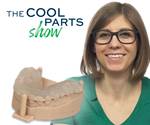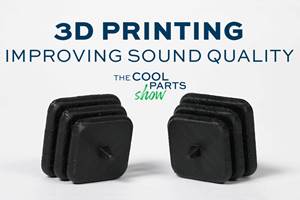Why Customization at Mass-Market Scale Is Finally Possible With 3D Printing
Printer speed and materials coupled with scanning technologies are contributing to more affordable and accessible 3D printed, personalized goods.
Producing personalized products at a mass-market scale has long been a dream in countless industries. Achieving this requires collaboration across many disciplines. Software developers, materials scientists, hardware engineers, manufacturing engineers and product designers all have a critical role to play.

Riddell’s SpeedFlex Precision Diamond football helmet features a 3D printed liner that is contoured to the player’s head anatomy. Source: Riddell
Finally, thanks to recent breakthroughs in additive manufacturing, that goal is within reach. And some consumer-products companies are already demonstrating the benefits of this approach to 3D printing end-use products.
Examples include the custom-fit helmet liners in the CCM Hockey headgear now worn by nearly 25 percent of National Hockey League players. There are also the Riddell football helmets used by thousands of National Football League and Division 1 college football players. Through a network of retail outlets that can digitally scan and precisely measure a person’s head in the store, these customized hockey and football helmets are now also available to consumers.
CCM’s Super Tacks X for hockey features a 3D printed NEST Tech lattice tuned for energy absorption. Source: Carbon
Likewise with custom-fit bicycle seats by Fizik. The company uses digital maps of a person’s bone structure and pressure points to design and produce a personalized saddle — the Fizik One to One — tailored to each rider’s body and motions.
Right now, such products typically carry premium price tags. But as customizable additive manufacturing becomes more widely used by consumer-facing manufacturers — and as the network effects and supply-chain logistics of the internet cloud enable supply-chain efficiencies — it’s only a matter of time. The economics of customized 3D printing are poised to make mass-market applications possible throughout the consumer products industry.
Dentistry Was the Early Adopter
Custom products from additive manufacturing aren’t entirely new, of course. The dental industry has a well-established track record of using 3D printing for night guards, models, dentures and other oral appliances. It was a sector suited to early adoption because dental appliances have always been tailored to the individual, and patients and insurers have been willing to pay for bespoke work.
As the technology advanced, sophisticated digital scanning tools for dentistry replaced the traditional method of making alginate or silicone casts of the patient’s mouth. Software that uses those digital scans to instruct a 3D printer has proven faster and, over time, became more accurate than the work even the most experienced artisan could perform using time-honored hand crafting.
For such 3D custom capabilities to move from medical specialty to the market mainstream, though, several technical advances had to coalesce:
Print Speed
Print speed directly translates to factory throughput and therefore cost per part. Manufacturing custom parts at scale requires printing at commercially relevant speeds. Recent advances in additive manufacturing have made this possible. This allowed for true 3D printing factories to spring up across the globe.
Materials
Consumer products must be robust and durable, especially in markets like sporting goods. Traditional 3D printing materials often fall short of the demanding list of required properties. New approaches to materials used in 3D printing have addressed these limitations and opened up new product categories, particularly in the elastomeric material space.
Scanning and Mapping
One key advance was the development of a broader array of digital scanners and human-body mapping software. In the case of sports gear, companies including Toolkit3D and GebioMized have developed tools and software that create customer data scans or pressure maps and integrate that information, over the cloud, with the files that control the 3D printers.
Fizik worked with GebioMized to develop a pressure sensor mat that can capture data about the rider’s position and anatomy in their true biking stance. Source: Fizik
Eventually, as smartphone cameras and software become ever more sophisticated, we might see the full democratization of scanning. Consumers might be able to conduct their own scanning for customized products we can only begin to imagine. And there are entrepreneurial engineers out there already exploring the possibilities.
One Size Does Not Fit All
Continued refinements in materials have been another enabler, of course. The helmets and bike seats we’re discussing aren’t made with conventional foam cushioning. They use elastomers with a software-configurable lattice structure.
The difference is demonstrated in printed lattice bike saddles. Seats made with foam are either uniform in their cushioning, or they provide different degrees of cushioning in various parts of the seat by joining various pieces of foam together. With an elastomer lattice, you can have a single part with thicker struts in areas where stiffness counts and thinner struts where more flexibility is needed.
Any rider can easily feel that difference. And based on scanning and pressure mapping, they can have a saddle with a lattice architecture design that is created specifically for their anatomy and riding technique.
Putting It All Together
Another key development has been years in the making. That’s the seamless integration of sensor mapping with digital design software and additive manufacturing hardware to make these customized product architectures fully feasible.
Along the way, too, have come continuous improvements in the 3D printers themselves. Rapid prototyping and refinement of design has long been an attribute of additive manufacturing. But now we have reliable production-grade printers that can be used for rapid prototyping as well as volume production in a manufacturing setting.
Reaching Escape Velocity
Although many customized consumer products currently fetch premium prices, that won’t always be the case.
The pure cost of a 3D printed custom part is typically between 5% and 15% of the retail price. And yet, this part might be produced in one facility, transported for assembly in another, and then shipped again to the customer. This additional time and energy in the supply chain translates to higher costs for the consumer.
Improving overall supply-chain efficiency will be a key factor in bringing costs down and enabling broader adoption. Software and automation can continually improve efficiency and remove links from the supply chain.
Certainly, there is no remaining technical barrier to mass-market customization. The technology I’ve described can very quickly scale to millions of customized parts.
As more consumer products companies — from the incumbents to the startups — recognize the advantages of additive manufacturing, we can expect market economics to work their inexorable magic.
Related Content
3D Printed Ductile Spikes for Better Sound Quality: The Cool Parts Show Bonus
Work on 3D printing flexible metal bellows has led to other applications, including the development of ductile spikes that sit between a speaker and the surface below to help limit vibration and isolate the audio equipment.
Read MoreFizik Utilizes Carbon DLS Technology for One-to-One Program, Creating Customized Bike Saddles
Fizik’s customized bike seat program uses Carbon’s Digital Light Synthesis technology and personalized rider data to create a line of truly custom saddles, giving bike riders the best bike seat for their posterior — only made possible through additive manufacturing.
Read More3D Systems Offers MJP 300W Printer, Wax Material for Advanced Jewelry Additive Manufacturing
The combination of the MJP 300W jewelry printer and VisiJet Wax Jewel Ruby enables jewelry designers to more efficiently achieve new designs with greater design freedom and improved surface finish.
Read More3D Printing Enables a Larger "Sweet Spot" Relative to This Golf Club's Size: The Cool Parts Show #77
Cobra Puma Golf's Limit3D iron uses 3D printed stainless lattices to remove weight from the interior so that it can be reintroduced with tungsten inserts that lower the center of gravity. The combination offers a smaller, sleeker club head with the forgiveness of a larger one.
Read MoreRead Next
Is Your Dentist a Manufacturer?: The Cool Parts Show #10
Dental devices have always been custom, but 3D printing is disrupting how they are made. We go inside a dental lab in this episode of The Cool Parts Show.
Read MoreFizik Utilizes Carbon DLS Technology for One-to-One Program, Creating Customized Bike Saddles
Fizik’s customized bike seat program uses Carbon’s Digital Light Synthesis technology and personalized rider data to create a line of truly custom saddles, giving bike riders the best bike seat for their posterior — only made possible through additive manufacturing.
Read MoreVideo: Orbit X Pro Football Helmet Uses 3D Printed Lattices
The lightweight helmet from Xenith will be used by NFL and collegiate football players beginning in fall 2024.
Read More























